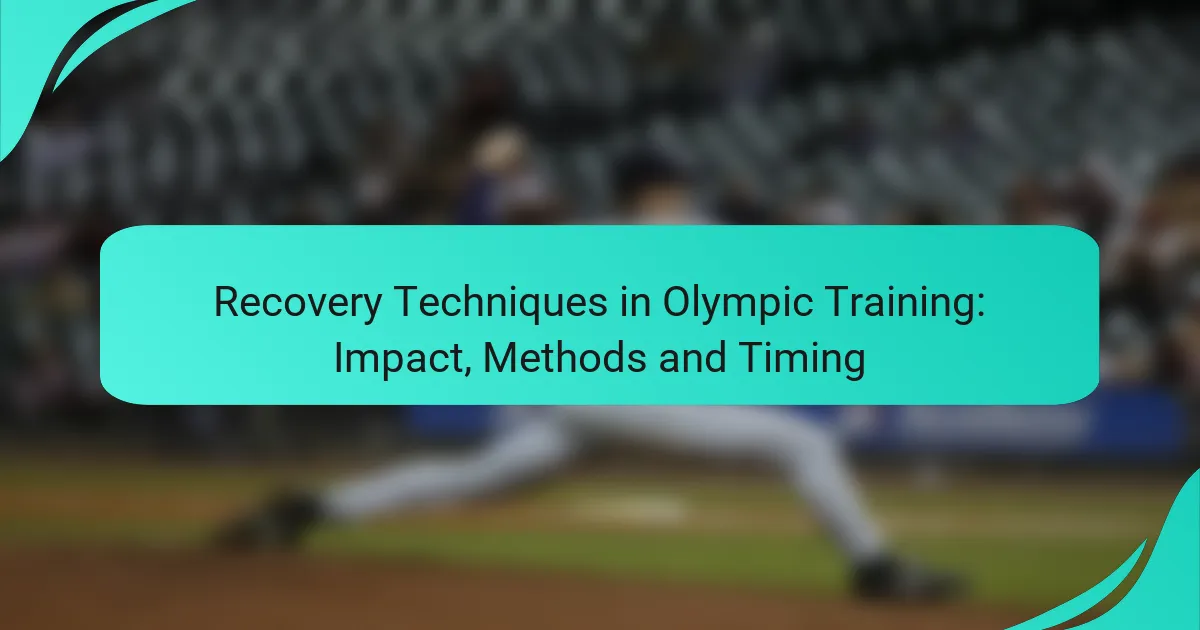Recovery techniques are vital in Olympic training, as they significantly enhance performance and help prevent injuries. Methods such as active recovery, cold water immersion, and nutrition strategies are crucial, while the timing of these techniques can further optimize muscle repair and reduce fatigue. Additionally, advancements in technology play a key role in monitoring performance and refining recovery processes for athletes.

What are the most effective recovery techniques in Olympic training?
Effective recovery techniques in Olympic training are essential for enhancing performance and preventing injuries. Key methods include active recovery, cold water immersion, massage therapy, nutrition strategies, and sleep optimization.
Active recovery methods
Active recovery involves low-intensity exercise that promotes blood flow to muscles without adding significant stress. Activities such as walking, cycling, or light swimming can help reduce muscle soreness and speed up recovery. Aim for 20-30 minutes of active recovery after intense training sessions.
Incorporating active recovery into your routine can improve flexibility and reduce fatigue. Consider scheduling these sessions on rest days or after high-intensity workouts to maximize their benefits.
Cold water immersion benefits
Cold water immersion, or ice baths, can significantly reduce muscle soreness and inflammation after intense training. Submerging the body in cold water for 10-15 minutes can help constrict blood vessels and decrease metabolic activity, leading to less swelling and tissue breakdown.
While effective, cold water immersion may not be suitable for everyone. Athletes should consider their individual tolerance and consult with a coach or sports scientist to determine the best timing and duration for this recovery method.
Massage therapy impact
Massage therapy can enhance recovery by increasing circulation, reducing muscle tension, and promoting relaxation. Techniques such as deep tissue massage or sports massage can target specific muscle groups and alleviate soreness. Regular sessions, ideally once a week, can help maintain muscle health.
However, timing is crucial; avoid intense massage immediately after training. Instead, schedule sessions within 24-48 hours post-exercise to allow muscles to recover while still benefiting from the therapy.
Nutrition strategies for recovery
Proper nutrition plays a vital role in recovery, with an emphasis on protein and carbohydrates. Consuming a meal or snack rich in these nutrients within 30-60 minutes post-workout can aid muscle repair and replenish glycogen stores. Aim for a ratio of about 3:1 carbohydrates to protein for optimal recovery.
Hydration is equally important; athletes should drink water or electrolyte-rich beverages to replace fluids lost during training. Monitoring fluid intake can help prevent dehydration and support overall recovery efforts.
Sleep optimization techniques
Sleep is crucial for recovery, as it allows the body to repair and regenerate. Athletes should aim for 7-9 hours of quality sleep per night. Establishing a consistent sleep schedule and creating a relaxing bedtime routine can enhance sleep quality.
Consider environmental factors such as room temperature, light exposure, and noise levels to improve sleep conditions. Avoiding screens and stimulants before bedtime can also contribute to better sleep and, in turn, more effective recovery.

How does timing affect recovery in Olympic athletes?
Timing plays a crucial role in the recovery of Olympic athletes, impacting their performance and overall training effectiveness. Properly timed recovery strategies can enhance muscle repair, reduce fatigue, and improve subsequent training sessions.
Post-exercise recovery windows
Post-exercise recovery windows refer to specific periods after training when the body is most receptive to recovery strategies. Research suggests that the first 30 to 60 minutes post-exercise is critical for replenishing glycogen stores and initiating muscle repair. Athletes should prioritize recovery activities during this window to maximize benefits.
During this time, techniques such as active recovery, stretching, and hydration can be particularly effective. Incorporating these methods immediately after workouts can lead to improved performance in subsequent training sessions.
Timing of nutrition intake
The timing of nutrition intake is essential for optimizing recovery in Olympic athletes. Consuming a balanced meal or snack containing carbohydrates and protein within 30 minutes after exercise can significantly enhance muscle recovery and glycogen replenishment. Aim for a ratio of about 3:1 carbohydrates to protein for optimal results.
In addition to post-exercise nutrition, maintaining regular meal times throughout the day supports overall recovery. Athletes should plan their meals around training schedules to ensure they are adequately fueled before and after workouts.
Frequency of recovery sessions
Frequency of recovery sessions is vital for sustaining performance levels in Olympic athletes. Incorporating recovery sessions into the training regimen, such as active recovery days or dedicated rest periods, allows the body to heal and adapt. A common approach is to schedule recovery sessions at least once or twice a week, depending on the intensity of training.
It’s important to listen to the body’s signals; if fatigue persists, increasing the frequency of recovery sessions may be necessary. Techniques like massage, foam rolling, and hydrotherapy can be integrated into these sessions to enhance recovery further.

What role does technology play in recovery?
Technology significantly enhances recovery in Olympic training by providing athletes with tools to monitor their performance and optimize their recovery processes. These advancements help in tracking physiological data, managing recovery routines, and improving overall athletic performance.
Wearable recovery tracking devices
Wearable recovery tracking devices, such as fitness bands and smartwatches, monitor vital signs like heart rate, sleep patterns, and activity levels. These devices provide real-time feedback, allowing athletes to adjust their training intensity and recovery strategies based on their physiological responses.
When selecting a wearable, consider battery life, accuracy, and compatibility with other training apps. Popular options include devices from brands like Garmin and Polar, which offer features tailored for athletes.
Recovery apps for athletes
Recovery apps help athletes manage their recovery routines by providing personalized plans, tracking progress, and offering educational resources. These apps often include features like guided stretching, hydration reminders, and nutrition tracking to support recovery.
Examples of effective recovery apps include Whoop and TrainHeroic, which allow users to log their recovery metrics and receive tailored recommendations. Look for apps that integrate with your wearable devices for a comprehensive overview of your recovery status.
Virtual reality in recovery training
Virtual reality (VR) is emerging as a unique tool in recovery training, offering immersive environments for rehabilitation and relaxation. VR can simulate various scenarios, helping athletes mentally recover while engaging in low-impact physical activities.
For instance, VR programs can guide athletes through rehabilitation exercises in a controlled setting, making the process more engaging. Consider using VR as a supplementary tool alongside traditional recovery methods to enhance mental focus and motivation during recovery periods.

What are the psychological aspects of recovery?
The psychological aspects of recovery involve mental processes that help athletes restore their focus, motivation, and emotional balance after intense training or competition. Effective recovery techniques can enhance performance by reducing stress and anxiety, promoting a positive mindset, and facilitating mental resilience.
Mental recovery techniques
Mental recovery techniques are strategies that athletes can employ to rejuvenate their mental state. These may include visualization, where athletes imagine successful performances, and positive self-talk to reinforce confidence. Incorporating short breaks for reflection and relaxation can also significantly improve mental clarity.
Another effective method is goal setting, where athletes outline specific, achievable objectives for both training and recovery periods. This can help maintain motivation and provide a clear focus, ensuring that mental energy is directed towards constructive outcomes.
Mindfulness practices for athletes
Mindfulness practices involve being present in the moment and can greatly benefit athletes during recovery. Techniques such as meditation and deep breathing exercises help reduce stress and enhance concentration. Engaging in mindfulness can lead to improved emotional regulation and a greater sense of well-being.
To incorporate mindfulness, athletes can set aside a few minutes daily for focused breathing or guided meditation sessions. Even simple practices, like mindful walking or stretching, can enhance awareness and promote relaxation, making them effective tools for recovery.

How do recovery techniques vary by sport?
Recovery techniques differ significantly across sports due to the varying demands placed on athletes’ bodies. Endurance sports often focus on methods that enhance cardiovascular recovery, while team sports may prioritize strategies that address muscle recovery and injury prevention.
Endurance sports recovery methods
In endurance sports like running, cycling, and swimming, recovery methods often emphasize hydration, nutrition, and active recovery. Athletes typically consume carbohydrates and proteins within 30 minutes post-exercise to replenish glycogen stores and repair muscles.
Active recovery, such as light jogging or swimming, can help maintain blood flow and reduce muscle soreness. Stretching and foam rolling are also common practices to enhance flexibility and alleviate tightness.
Team sports recovery strategies
Team sports like soccer, basketball, and rugby require recovery strategies that focus on both physical and tactical recovery. Ice baths and contrast water therapy are popular for reducing muscle soreness and inflammation after intense matches.
Nutrition plays a critical role; athletes should aim for a balanced intake of carbohydrates, proteins, and fats to support recovery. Additionally, adequate sleep and rest days are essential for maintaining performance and preventing injuries.
